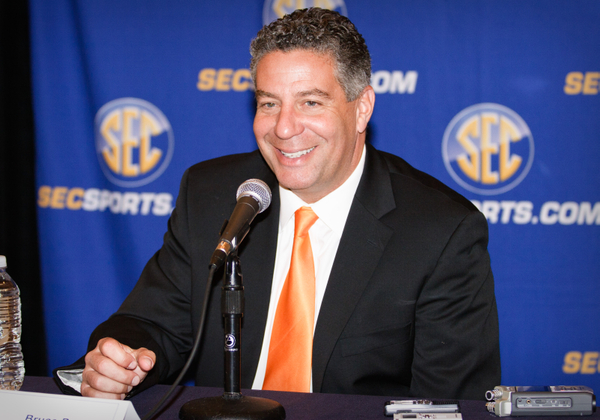What We Can Expect From Auburn in Bruce Pearl’s First Year
Posted by Greg Mitchell on October 16th, 2014The SEC’s basketball profile will continue to flounder until some of the other 12 programs other than Florida and Kentucky develop into consistent winners. The conference needs the depth of several year-in, year-out NCAA bid contenders to complement those two crown jewels. Suddenly, Auburn, which hasn’t had a winning season since 2008-09 and hasn’t been ranked in over 10 years, looks as ready as anyone to make that leap. The reason? Simple. Bruce Pearl’s return to the conference.
The former Milwaukee and Tennessee coach has already provided a jolt in fan support and recruiting since being hired last spring. For example, in late August he signed three key recruits in four days to give Auburn one of the current best 2015 recruiting classes in the conference. It’s a virtual certainty that this excitement will eventually lead to on-court improvement, but how soon is it reasonable to expect? If his past performance is any indication, it might be sooner than you think. Below we examine how Pearl fared in each of his first years leading the Panthers and the Vols.
2001-02 Milwaukee Panthers
What happened: Pearl took over when Wisconsin hired a coach named Bo Ryan, who had gone only 30-27 in his two seasons at Milwaukee. At 16-13 overall, the Panthers won only one more game in Pearl’s first season than they had the year before, and there was no postseason. Nevertheless, Milwaukee jumped to third place in the Horizon League (11-5) after finishing fifth (7-7) in Ryan’s last year (in what was then unimaginatively called the “Midwest Collegiate Conference”). Not surprisingly, Pearl revved up the pace of action (72.7 possessions per 40 minutes) over Ryan’s more disciplined approach (65.3), but this didn’t necessarily yield better efficiency since the Panthers scored and allowed roughly the same number of points per possession and didn’t see a big uptick in free throw attempts. The biggest reason for the slight improvement in the conference standings seems to have been better play from a trio of junior guards: Clay Tucker, Ronnie Jones, and Jason Frederick. The diminutive Jones (5’9’’) made the biggest jump, upping his scoring average by seven points per game and dishing out an additional assist per contest.
Auburn is a good bet to improve on its 2013-14 SEC standing (12th) given an influx of new talent (Niagara transfer Antoine Mason, junior college transfer Cinmeon Bowers, and New Mexico State transfer K.C. Ross-Miller), so there may be a lazy correlation there. But optimistic Auburn fans may want to point to Jones if they seek a takeaway from Pearl’s first year in Milwaukee. Sophomore Tahj Shamsid-Deen is a similarly diminutive guard who showed great promise last season (10.4 PPG and 2.6 APG in SEC play). Although every player is different and some improvement can be driven by experience and maturity, Pearl has had first-year success with a player like Shamsid-Deen before.
2005-06 Tennessee Volunteers
What happened: Pearl experienced massive success in his first year in Knoxville, as the Vols had risen as high as #8 in the AP poll during the season and were ranked #18 in the final poll. Pearl engineered eight more wins (22-8) than Buzz Peterson did during his swan-song season (14-17), and capped it off with a win over Winthrop in the NCAA Tournament. Like in Milwaukee, significant improvement from incumbent players drove that team’s success. The difference was that this group included a future NBA regular in senior guard C.J. Watson and a future All-American in sophomore guard Chris Lofton. The perimeter-oriented offensive attack also featured a giant leap from sophomore guard JaJuan Smith, who went from a little-used freshman to a solid contributor (9.5 PPG). Pearl again coaxed his personnel to play at a faster pace than his predecessor, increasing the Vols’ possessions per 40 minutes from 67.0 to 73.7. Unlike in Milwaukee, however, this faster attack led to a more potent offense (1.09 points per possession, up from from 1.03 under Peterson).
The Takeaway
All of this suggests we can expect to see two things at Auburn this year: Pearl’s trademark up-tempo system, and a guard-oriented offensive attack. Pearl doesn’t have the talent he had in his first year at Tennessee but the cupboard isn’t completely dry either. Shamsid-Deen is a promising young player, and both K.T. Harrell and Mason are proven Division I scorers (even if they might find it difficult to share shots). These players, along with Ross-Miller, should give Pearl the backcourt personnel he needs to be effective while speeding up an offense that averaged 69.4 possessions per 40 minutes last season (which was just above the SEC average of 68.4).
One final bullet for the optimistic Auburn fan involves the work Pearl did with Vols senior center Major Wingate in 2005-06. Wingate enjoyed a massive leap in efficiency from his junior to senior year, bumping his field goal percentage up by five percentage points (50.5 FG% to 55.6 FG%) and doubling his scoring average (5.0 PPG to 10.6 PPG). Pearl scored a big early win in his new job by getting a commitment from the 6’7,’’ 261-pound Bowers, a former Florida State signee and the top rated junior college transfer. The Tigers would have a diverse attack if Pearl and his staff can develop Bowers into the kind of consistent offensive threat Wingate was so many years ago.












































